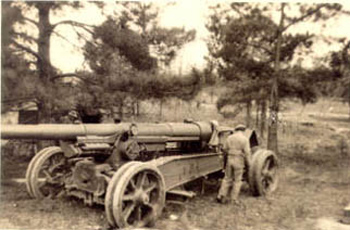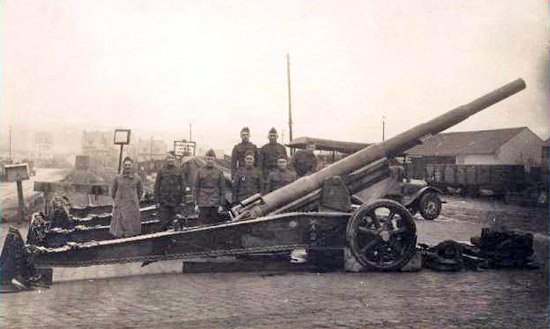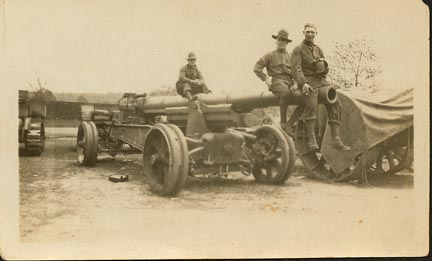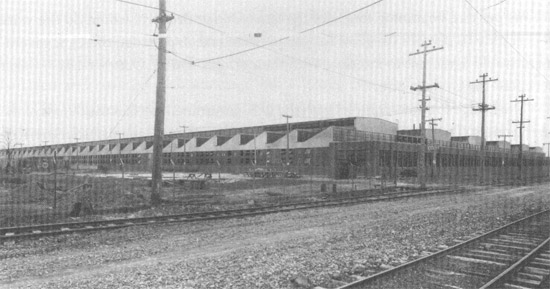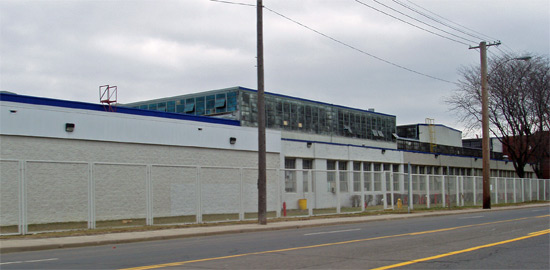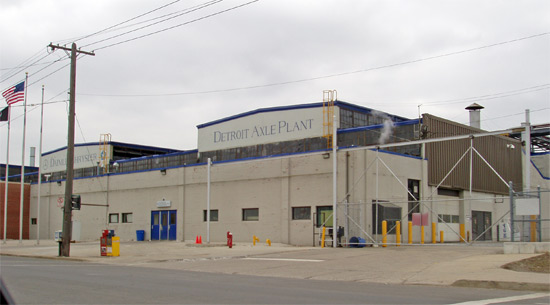Kkirbitz Member Username: Kkirbitz Post Number: 11 Registered: 10-2006 |
Aiw - David Buick was married in Detroit in 1878 and moved his engine business to Flint around 1903, so that should put him at 373 Meldrum around 1902 and earlier. | ||
Aiw Member Username: Aiw Post Number: 6078 Registered: 10-2003 |
The 1889 map doesn't show a house at 373 Meldrum yet, but the 1897 map does: 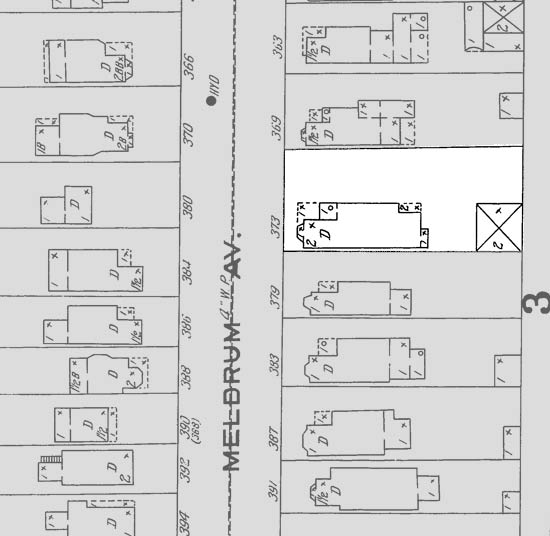 A 2 story dwelling, wood framed, with a 2 story garage behind. Both have cedar shingle roofs. | ||
Aiw Member Username: Aiw Post Number: 6079 Registered: 10-2003 |
Erratum... the map is upside down, and the house was on the west, not the east side of Meldrum. | ||
Aiw Member Username: Aiw Post Number: 6080 Registered: 10-2003 |
Looks like it's a vacant lot today. http://www.google.ca/maps?f=q& hl=en&q=373+meldrum,+detroit,+ mi&ie=UTF8&z=18&ll=42.349723,- 83.012309&spn=0.002823,0.00672 7&t=h&om=1 | ||
Kkirbitz Member Username: Kkirbitz Post Number: 12 Registered: 10-2006 |
Vintage Christmas greetings from Buick as well . . . 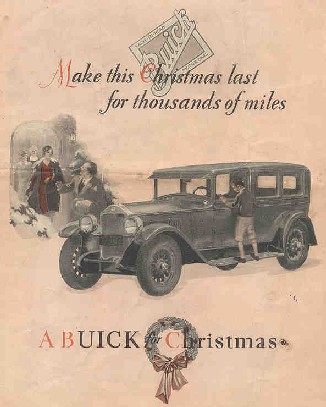 | ||
Kathleen Member Username: Kathleen Post Number: 1809 Registered: 10-2003 |
AIW: What cross streets was 373 Meldrum between? Just want to be sure that I understand where, in today's Detroit, that address was. Thanks. | ||
Aiw Member Username: Aiw Post Number: 6086 Registered: 10-2003 |
Block south of St. Paul. | ||
Kathleen Member Username: Kathleen Post Number: 1811 Registered: 10-2003 |
Thanks much, AIW!! | ||
Iowaboy Member Username: Iowaboy Post Number: 45 Registered: 08-2006 |
On Mt. Elliott Street across from the GM Hamtramck Assembly plant there is a four-sided building of about eight stories in height. Bill Cuthbert in his book "The Hupmobile Story from Beginning to End" says that Hupp purchased the Huebner Lumber and Manufacturing Co across from Hupp in 1928 and that in 1936 Hupp sold an eight-story building they had used for the storage of new cars. Old aerial photos seem to show some sort of connection/bridge/something from the main plant to the building across the street. I am wondering if the building currently across the street from the GM facility is the same building that was used by Hupp. What is the current use of the building? Any comments? | ||
Kathleen Member Username: Kathleen Post Number: 1852 Registered: 10-2003 |
Michigan's State Historic Preservation Office has recently approved a Michigan historic marker to recognize the Dodge Brothers and the Dodge Main Plant, to be placed at Veterans Memorial Park, Joseph Campau Street, Hamtramck. Source: http://www.michigan.gov/hal/0, 1607,7-160--159359--,00.html | ||
Cambrian Member Username: Cambrian Post Number: 495 Registered: 08-2006 |
An interesting Flea Market find.... 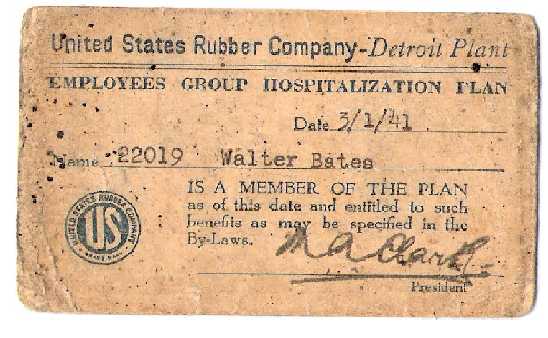 | ||
Cambrian Member Username: Cambrian Post Number: 496 Registered: 08-2006 |
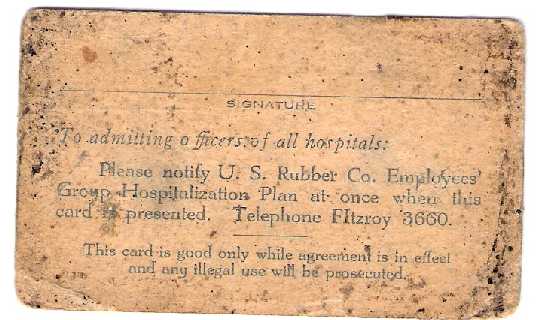 | ||
Livernoisyard Member Username: Livernoisyard Post Number: 2145 Registered: 10-2004 |
Walter Bates probably died in spite of that healthcare plan. | ||
56packman Member Username: 56packman Post Number: 884 Registered: 12-2005 |
Kathleen, the original cast brass "DB" emblem from the Dodge main (pronounced "Dache main")gate is on display at the Walter P. Chrysler museum in Auburn Hills. | ||
37packard120 Member Username: 37packard120 Post Number: 1 Registered: 01-2007 |
Homewrecker or 56Packman...above Homewrecker posted some photos from "Packard Ave"....would anyone know what street that is today? And/or where that is located at the Plant? I am trying to get my bearings as to where those photos were taken... Thanks | ||
Woodwardave Member Username: Woodwardave Post Number: 1 Registered: 01-2007 |
Can anyone give me any information on Chrysler's Eldon Avenue Gear and Axle plant? I worked there in 1968-1969 while I was in college. It was a pretty nasty place. Is it still owned by Chrysler? Is it still open? | ||
Quozl Member Username: Quozl Post Number: 98 Registered: 07-2005 |
Horn_Wrecker: Thanks for the link to the Massey-Ferguson Thread. Having grown up on Archdale & Glendale I remember Ferguson Park all too well. In the early 60's we use to play in the "Big Field" south of Glendale and Longacre and ride our bikes on the hills of dirt back there. We saw Massy-Ferguson tractors rolling out of the plant all the time The "cool" thing in our neighborhood back then was having these black knobs on the axles of your bicycle. They were referred to by all the kids as "N*gg*r Knobs" though at that time I had no idea what that meant. The Detroit News paperboy (Route 35) would sell you one for 25 cents though at the time we did not know where they were actually from or what they were used for. In the summer of '64 when we were bored we climbed over the fence of the "Big Field" facing Fullerton and the railroad tracks running parallel watching the 100's of tractors rolling out of Ferguson Park. When the locomotive stopped I climbed aboard one of the flatbed railcars and hopped on one of the tractors. I had finally found the source of the knobs; they were the gearshift knobs of the Massey-Ferguson tractors. There were all different diameters of knobs for the taking. Well, my buds and me thought we were going to be wise guys and proceeded to strip about 50 tractors of their knobs. Being a good Roman Catholic boy going to Our Lady Queen of Hope I felt GUILTY and actually confessed to the priest that I was stealing knobs from the tractors. I said three "Hail of Mary’s" and an "Act of Contrition" and all was well. We continued this larceny for about 1 more week until we got busted red handed by Massey-Ferguson's finest and the DPD. When the cops drove me home and told my parents I was in deep dookie. The worst part was showing my Dad the stash of knobs I had in the attic of the garage and having to take them back to Massey-Ferguson that afternoon. I surrendered nearly 400 of the knobs and could not sit on my butt for 2 weeks after my Dad wasted my ass for stealing. My Dad was equally furious over the nickname for the knobs and I vividly remember getting my mouth washed out with soap for saying it. Thanks again for the link and your phenomenal input to this forum. I always appreciate your insight, knowledge and photographs. | ||
56packman Member Username: 56packman Post Number: 918 Registered: 12-2005 |
37packard120--the shot of "Packard avenue" is inside the plant. the building to the left in the top picture (the one with the "Quality first" sign) was torn down in the 1999 illegal coup attempt. The name "Packard avenue" is a company name, not a city of Detroit designation. You might know me from the AACA forums as "Mr. Pushbutton" | ||
Mikem Member Username: Mikem Post Number: 2952 Registered: 10-2003 |
WoodwardDave, welcome to the forum! Eldon Avenue is still owned by Chrysler (DCX) and is referred to as "Detroit Axle". On page 4 of this thread (in the archives, link at top of this page) I posted a story about a tragic event at the plant which happened shortly after you worked there. Go to this site: Black Cats,White Cats,Wildcats: Auto Workers in Detroit ...and scroll down to "Niggermation In Auto: Company Policy and the Rise of Black Caucuses". It also describes Eldon as a "nasty place". Please, tell us some memories of working there. Anything. Was it hot, fun, scary, noisy, crazy? Did you work your ass off or did you do your best to hide out? I have some more history of the place buried in notes on my desk - I'll post it eventually. It was built by the Dodge brothers during World War I to build a French-designed artillery. | ||
Woodwardave Member Username: Woodwardave Post Number: 2 Registered: 01-2007 |
Hi Mikem, Thanks for the information. At the risk of sounding vengeful, I am slightly disappointed that the plant hasn’t been leveled. As I indicated, it was a pretty nasty piece of work. I don’t have a lot of good memories. The sad thing is that working there was easier for me. I knew that I would be going back to school. I could see a light at the end of the tunnel. To most of the others at Eldon, this was how things were going to be for the long term. My first day there, I was processed through personnel and taken to my work area. It was like being guided by the ghost of Virgil through Dante’s Inferno finally arriving at the first ring of the seventh circle of hell; better known as “Axle Assembly.” I don’t know what it is like today, but back in 1968 it was hot, dirty and breeding ground for discontent and violence. Management and the union didn’t get along. The axle assembly area was about 75-80% black and they didn’t feel that the union was representing their interests. As a result, there were several unofficial unions trying to establish themselves. One of these splinter groups probably led to the formation of ELRUM and other “revolutionary” groups. A lot of turf wars. This being said, I did meet some great people there. But the working and social conditions were such that the whole place was a bomb waiting to go off. The bomb did go off about a year later with the James Johnson incident (thanks for the link). As you come across more information, please let me know. The time I spent there had a profound impact on how I view the world today. | ||
Mikem Member Username: Mikem Post Number: 2962 Registered: 10-2003 |
Thanks Dave. Your experience sounds very similar to Philip Levine's: http://www.randomhouse.com/knopf/authors/levine/poetsonpoetry.html Sounds as if you're no longer in the area. Eldon is still up and running (I think), the neighboring Lynch Road Assembly plant is closed as is the Huber Avenue Foundry. Both are being used as warehouses. Eldon has to be one of the oldest buildings in use by Chrysler. I can't remember if the Winfield Avenue foundry was operational while you were at Eldon, but it's been demolished for quite some time: 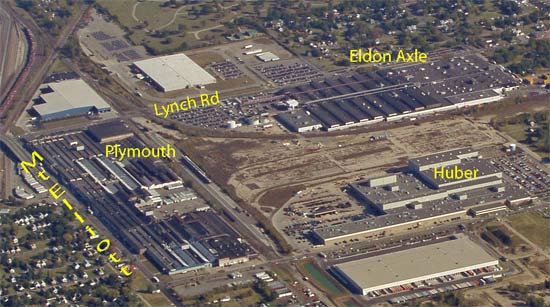 I can't offer much more about Eldon other than this from Charles Hyde's recent book, "The Dodge Brothers: The Men, The Motor Cars, and The Legacy" quote: After a few pages describing the manufacturing process, the difficulties obtaining materials, and some production problems, he finishes the section with this: quote: Foch also visited a new school named in his honor, the Foch Intermediate School: 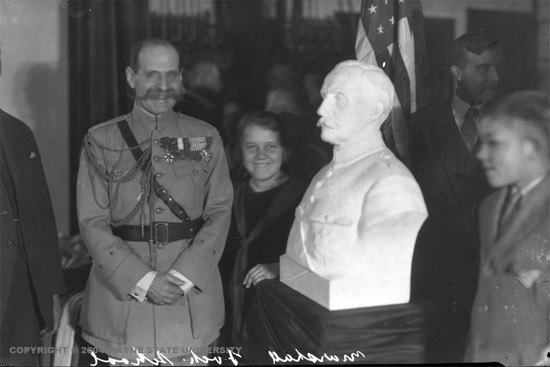 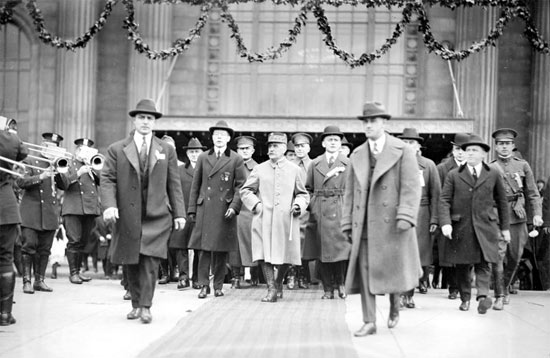 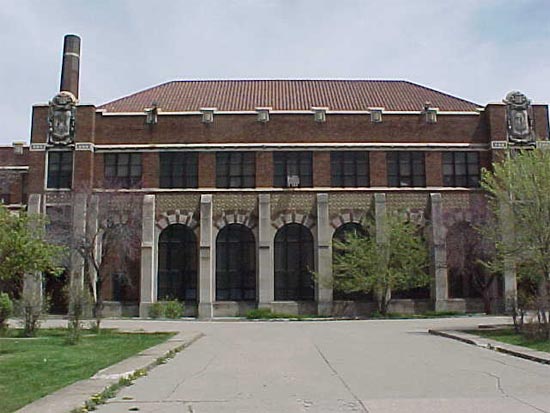 | ||
37packard120 Member Username: 37packard120 Post Number: 2 Registered: 01-2007 |
56Packman,,,,following up to Packard Plant info Was hoping to send you a PM but it doesn't look like I am able to on here. If you wouldn't mind, my personal e-mail address is DonKraper@LocustGroveHouse.com I promise not to bother you too much.  In the meantime, heres one, and I looked through the Archives with no luck. Would you know what the Building on the Corner of Concord and Ferry was used for? It currently has a Packard Banner on it. And I really can't tell who or what business is in the Building now. Thanks again for any info... Don | ||
Aiw Member Username: Aiw Post Number: 6135 Registered: 10-2003 |
Don, That was at one time a school. | ||
Iowaboy Member Username: Iowaboy Post Number: 46 Registered: 08-2006 |
To Quozl, Could you please contact me (Iowaboy) at my email address of johniwen@yahoo.com I am a Ferguson/Massey Ferguson tractor fan and found your story very interesting. | ||
Mikem Member Username: Mikem Post Number: 2964 Registered: 10-2003 |
Is this the building you were asking about? http://atlas.freshlogicstudios.com/?cp=42.382783144558004~-83.03571937316285&style=o&scene=42.382783144558004 It was recently re-sided but I don't know what its current use is. I think it was (is) a steel warehouse. I see the bridge was removed sometime between 1949 and 1952: 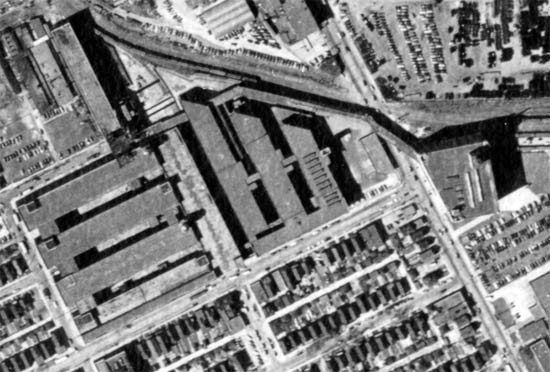 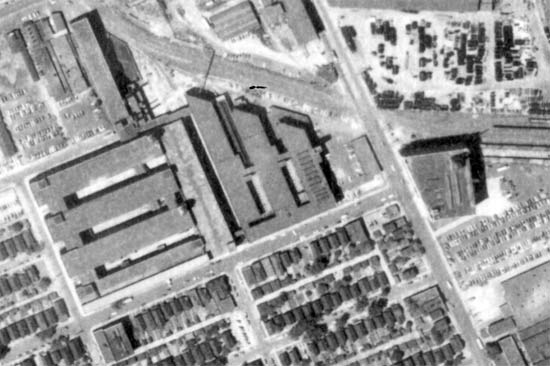 | ||
Quozl Member Username: Quozl Post Number: 104 Registered: 07-2005 |
Iowaboy: Will do! | ||
37packard120 Member Username: 37packard120 Post Number: 3 Registered: 01-2007 |
Thanks Aiw!! | ||
Bate Member Username: Bate Post Number: 78 Registered: 02-2005 |
Hey Mike, the atlas freshlogic map program (link) is pretty cool; very similar to msn's mapslive, though the birds eye view won't rotate 360 around a fixed point. While checking some aerial views, I was wondering if you know what the buildings at the east end of Piquette at Russell St are? Rivard St and Harper are the other corners. | ||
56packman Member Username: 56packman Post Number: 928 Registered: 12-2005 |
MikeM- that building on the Freshlogic map is the JW Coles warehouse. They store a lot of auto show displays (called "kits" in the industry) there. It's a big place, still used and maintained. It's on Mt. Elliot (major street ot the left of the building in the photo). But that dosen't explain the building at Concorde and Ferry for my Packard buddy 37packard120. That would be the school building that Dominic Christini owns (owned?) Dominic is the embattled owner of the Packard plant, with the CoD as the title-holder, thanks to the State of Michigan. | ||
37packard120 Member Username: 37packard120 Post Number: 4 Registered: 01-2007 |
Thanks again for the info Packman...I spent a couple of hours looking for information on the school last night, and all I found were other abandoned schools in Detroit. (thats sucks)  I would think that if it was a School House, it would at one time been full of Packard Employees children. I am going to keep searching for information regarding it. Its kinda cool that the Banner is up there, even though its falling down. But thats just so indicative of the area. I would think that if it was a School House, it would at one time been full of Packard Employees children. I am going to keep searching for information regarding it. Its kinda cool that the Banner is up there, even though its falling down. But thats just so indicative of the area. My Girlfriend had a conversation with some of the security guards several months ago at the Plant, (through the gate). She had asked why the North Side of East Grand, was more secure than the South Side. They had told her that there was some areas that still has its originality to it. (which I find hard to believe). I guess in a way I hope there is some items that are still preserved. From what I have read in the Achieves, it seems like most of contents from the plant were destroyed or landed at the bottom of the river. Here is a shot of the School Building across the street from the Plant taken about 4 months ago. 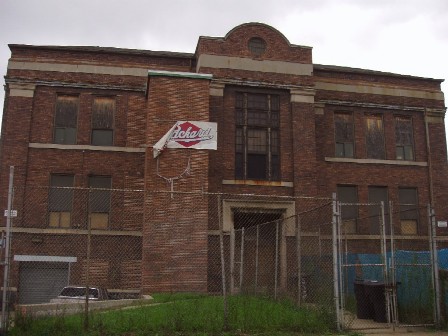 | ||
Mikem Member Username: Mikem Post Number: 2965 Registered: 10-2003 |
That was the Thomas Elementary School, E Ferry at Concord. Packman, thanks - I thought it belonged to Detroit Steel up the street. Sounds as if it belonged to Hupp originally. Bate, are these the buildings you are asking about? 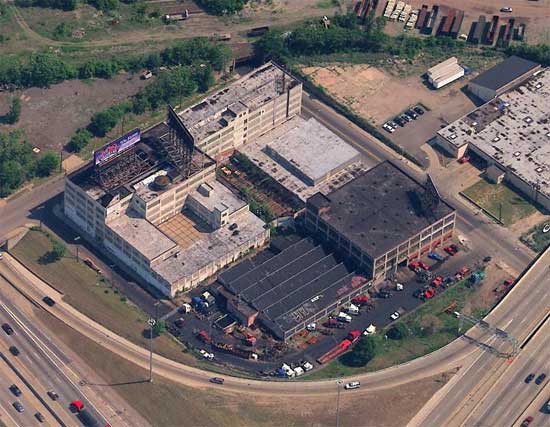 I think they were part of the American Blower complex, makers of industrial ventilation systems. | ||
56packman Member Username: 56packman Post Number: 930 Registered: 12-2005 |
That was American Blower, later Square D electric, then Volunteers of America. My buddy is co-owner of that building. | ||
Bate Member Username: Bate Post Number: 79 Registered: 02-2005 |
Thanks Mikem and 56Packman for the info on the buildings in question. I thought they might have been part of the Fisher empire that dominated that area. Nice mix of building types in that complex. On a Packard note, I'm in agreement with 37Packard on the northern most portion (Concord & Edsel Ford Fwy end) of the Packard plant being in much better shape. This section looks more modern with the windows bricked-up. It almost looks as if this section could be in use. Possibly storage? Was this portion of the plant the aviation section as I have heard? | ||
Iowaboy Member Username: Iowaboy Post Number: 47 Registered: 08-2006 |
Mikem, yes that is the building I had in mind. Hupp bought the Hueber Manufacturing Co property across Elliott Ave from Hupp. So it appears that building was used by Hupp to store automobiles. Does that make sense. US Steel later bought the property so it very likely was used for steel storage. Can't be positive, but from the various aerial views, it looks like the same building. | ||
56packman Member Username: 56packman Post Number: 933 Registered: 12-2005 |
The northern part of the Packard plant, from East Grand boulevard North is the older part of the plant, the office building dates to the 1907 expansion, as a two story building, then a few years later the upper floors were added. The portion along Concorde to the Edsel Ford freeway was built in 1942 for the production of Rolls-Royce Merlin aircraft engines. Packard took what had been a typical British nightmare--hand-fitted bolt holes from flange to flange, no real interchangeable parts and made a uniform, high precision mass produced engine. Packard made 55,000 of these engines in three years. After the was that space became engineering and styling. The portion south of the boulevard was built largely in 1934-5 for the production of car bodies for the "120" and "110" models--their assembly line ran down the east side of that building while the big cars still had a U-shaped assembly line on the first floor of the north portion of the plant. There was a powerhouse where the supermarket building stands today on the south side of the blvd and there was a foundry and forge that was demolished to make way for the I-94 ditch. It stood right where the freeway is today. | ||
Bate Member Username: Bate Post Number: 80 Registered: 02-2005 |
Checking some old links I have, I stumbled on to a new photo from 12/06 showing the Fisher Building at Fort and Livernois being demolished. Can anyone confirm? | ||
Mikeg Member Username: Mikeg Post Number: 488 Registered: 12-2005 |
I noticed last weekend as I drove by in the I-75 ditch that the former Fisher Body Fort Street Plant administration building was no longer standing. That was originally a Ternstedt building and they were ultimately absorbed by the Fisher Body Division of General Motors in 1968. I interviewed there for a production supervisor job in September of 1975 while I was laid off from GM. Fortunately, I got called back to my engineering job at the Fisher Body General Offices before I had to make a tough decision. | ||
Bate Member Username: Bate Post Number: 81 Registered: 02-2005 |
Yea, Mikeg this would be the one. Photo credit forgottenmichigan. 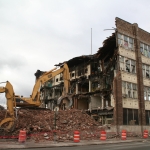 | ||
Woodwardave Member Username: Woodwardave Post Number: 3 Registered: 01-2007 |
Hi Mikem, Thanks, for the link to Philip Levine. I liked it so much I bought the book. About 18 years elapsed between our "tours" in the auto plants but the impressions and experiences were eerily similar. | ||
Aiw Member Username: Aiw Post Number: 6142 Registered: 10-2003 |
Here's a few pictures from July. http://internationalmetropolis .com/?p=176 | ||
Kathleen Member Username: Kathleen Post Number: 1900 Registered: 10-2003 |
Thanks for the news about the Fisher Body Fort St./Livernois building being razed. We haven't been by that intersection since our visit to Fort Wayne in October. I'll have to make a note in the old photo album as I did take a number of photos of the building for both its automotive history and its artfully painted windows! | ||
Bate Member Username: Bate Post Number: 82 Registered: 02-2005 |
Aiw, Is the factory portion behind the Fisher Fort St. building still there, or was it razed as well? It's hard to tell form the photo I posted. | ||
Sven1977 Member Username: Sven1977 Post Number: 202 Registered: 04-2004 |
There's a photo of the old Ternstedt factory at the end of this article. http://www.geocities.com/sponc om26/HistoryTernstedt14.html | ||
Aiw Member Username: Aiw Post Number: 6148 Registered: 10-2003 |
Bate, I'm not sure, I haven't been by since the demolition. | ||
Mikeg Member Username: Mikeg Post Number: 539 Registered: 12-2005 |
During my 60 mph "drive-by" last month, it appeared to me that the factory portion still stands. It had the name of an auto supplier in large lettering on the side facing I-75, but I can't remember the name. | ||
Sven1977 Member Username: Sven1977 Post Number: 203 Registered: 04-2004 |
The Atlas map program is a lot of fun. In an overhead, the old Lincoln plant is there. In the birdseye view, it's gone. Wreaked before the satellite made it around again. What is the factory or warehouse on Tireman west of Central? There's a complex of buildings just south of there. Is that a prison? | ||
Livernoisyard Member Username: Livernoisyard Post Number: 2387 Registered: 10-2004 |
Not sure of its exact location, but there was a Wolverine plant on Central in that general area in addition to the one by the Detroit Line ROW heading to Toledo. | ||
Mikem Member Username: Mikem Post Number: 3019 Registered: 10-2003 |
Sven, that factory on Tireman is just over the city limits in Dearborn. No one seems to know its history. I think I found that it was a steel processing facility, but I'm unsure of its original purpose and owner. The prison-looking complex southwest of it is the Springwells water pumping station, supplying water the the west side and western suburbs. Largest plant of its kind when it was built. | ||
Aiw Member Username: Aiw Post Number: 6149 Registered: 10-2003 |
Here's the Tireman Factory. I assume that we are talking about the one that I've circled right? 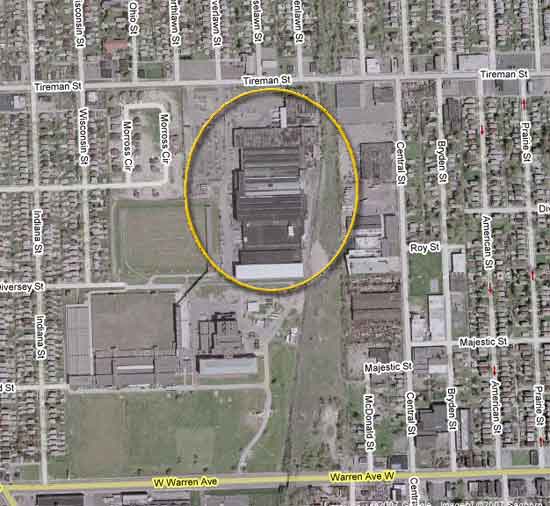 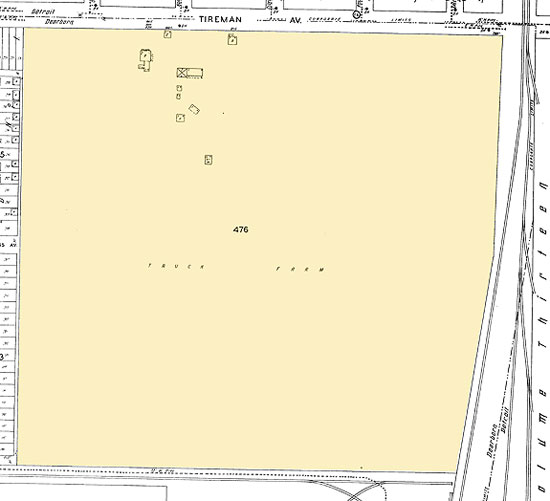 The 1930 Sandborn map shows the area as a vacant field. It's listed as "Truck Farm". You can see the Dearborn/Detroit border as the dashed line that runs through the train tracks. 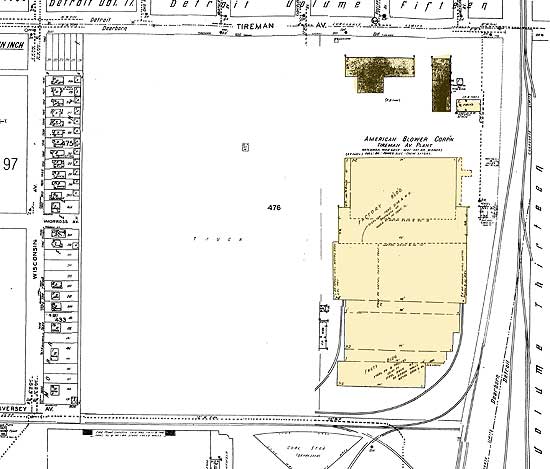 The 1930 map, revised to 1950, shows the good old American Blower Corporation as being in the factory. It was built some time after 1930. 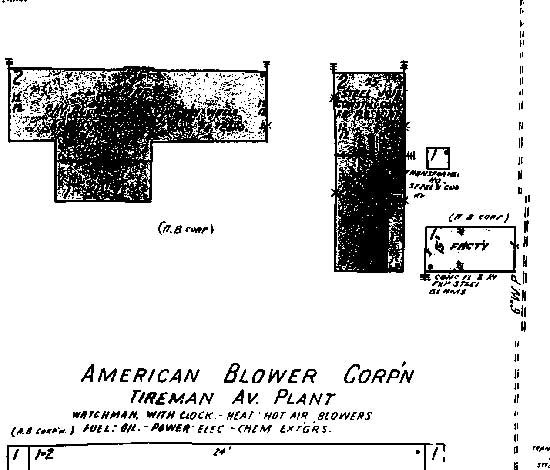 Interesting to note that the buildings in the N.W. corner of the property appear to still be standing today. 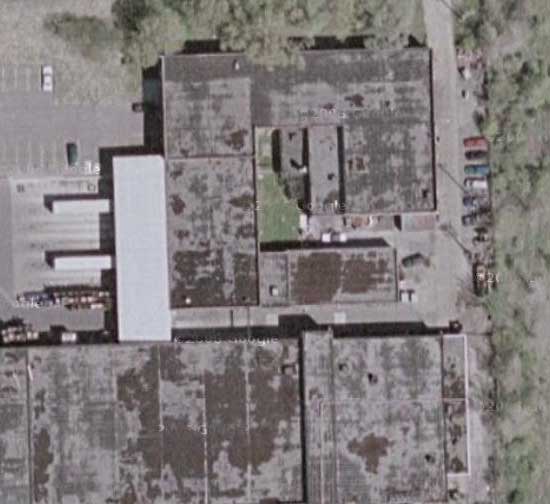 The two rectangular buildings on the right of the picture above are now incorporated into the area behind the loading dock. | ||
Mikem Member Username: Mikem Post Number: 3020 Registered: 10-2003 |
Thanks AIW, I remember that now. I thought it might have been a former Chrysler plant because of the color. American Blower: 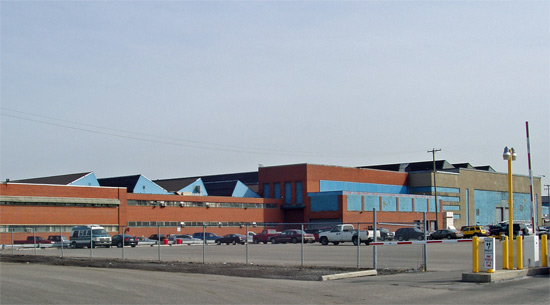 | ||
Kfcoupe Member Username: Kfcoupe Post Number: 1 Registered: 02-2007 |
Hi... Would the group be interested in photos taken inside the Continental Engines plant on East Jefferson during the years Kaiser-Frazer ran it as the Detroit Engine Division...including Korean War era pictures showing the R-1300 radial engines built for the Navy? Also, is Willow Run MI during the Kaiser-Frazer years considered part of Detroit car plants...I saw Livonia pictures in one of the previous groups. Please let me know at kfcoupe@scrtc.com. I am new to the group and don't want to put up anything not considered proper. | ||
Mikem Member Username: Mikem Post Number: 3032 Registered: 10-2003 |
Absolutely. Let us know if you need help posting pictures. | ||
Kfcoupe Member Username: Kfcoupe Post Number: 3 Registered: 02-2007 |
Hi, I tried to post a pic this morning only to find out that the file size was too big for an attachment (50kb max attachment, my pics 150kb or more). Will try to get some stuff up over the weekend. Jack Mueller | ||
Kfcoupe Member Username: Kfcoupe Post Number: 4 Registered: 02-2007 |
Here's a starter. I will have to resize and copy the pictures on file as they were scanned at 300 dpi and file sizes exceed what's allowed for attachments. 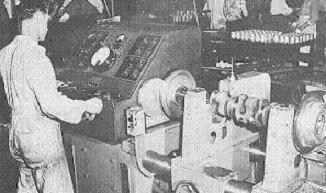 | ||
Kfcoupe Member Username: Kfcoupe Post Number: 6 Registered: 02-2007 |
Sorry about that...I had one picture that would work. He's checking the balance on a crankshaft for a 226 cubic inch engine used in Kaiser or Frazer automobiles, 1947. | ||
Aiw Member Username: Aiw Post Number: 6152 Registered: 10-2003 |
Excellent. Looking forward to seeing your photos. | ||
Mikeg Member Username: Mikeg Post Number: 553 Registered: 12-2005 |
Kfcoupe, I use Irfanview to quickly "resize" and "save as" my images. It can be downloaded for free from here: http://www.irfanview.com/ | ||
Kfcoupe Member Username: Kfcoupe Post Number: 8 Registered: 02-2007 |
Engine block assembly line at the Detroit Engine Division plant (former Continental Engines factory on East Jefferson) at the end of 1946, just after Kaiser-Frazer took over operations. 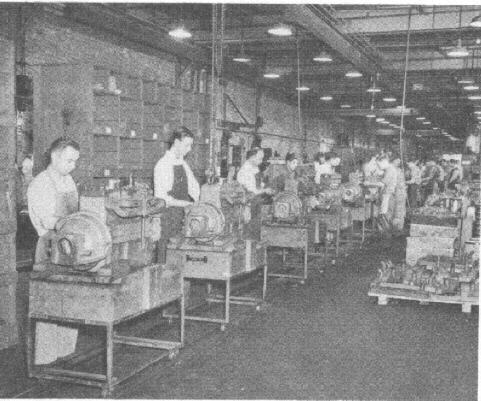 | ||
Kfcoupe Member Username: Kfcoupe Post Number: 9 Registered: 02-2007 |
Something a bit different. During the Korean War, the Kaiser-Frazer plant at Willow Run, just outside Detroit produced C-119 cargo planes. Here an engine is mounted on an in-process C-119. Cars continued to be built in another part of the factory. 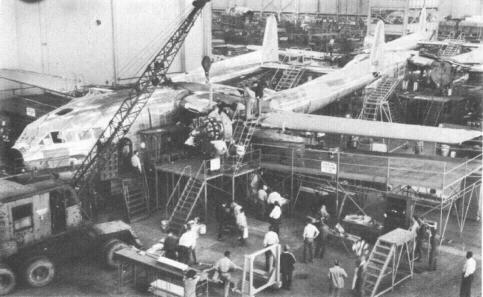 | ||
Kfcoupe Member Username: Kfcoupe Post Number: 17 Registered: 02-2007 |
Here's a 1952 photo taken towards the end of the final assembly line at the Detroit Engine Division plant (the former Continental Engines plant on East Jefferson) showing final activities on Wright R-1300 engines. Kaiser-Frazer built these under contract to the Navy. 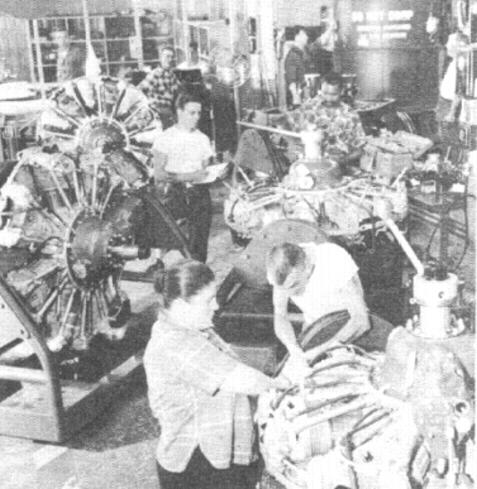 | ||
Kfcoupe Member Username: Kfcoupe Post Number: 18 Registered: 02-2007 |
Here's a 1947 vintage photo from the K-F plant at Willow Run, showing the station on the chassis line where completed engines (some from Continental in Muskegon, some from K-F's Detroit Engine Division plant) were installed. 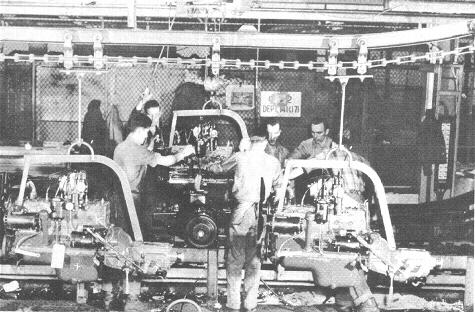 | ||
37packard120 Member Username: 37packard120 Post Number: 5 Registered: 01-2007 |
A quick question regarding the Packard Plant. I was there this past weekend checking out what is still left, (which is basically nothing)....one thing we noticed was the wood flooring in a lot of areas. Some was tongue and groove planks, and other areas, had wood "bricks"...my question is regarding this flooring. Why did they put the wood floors over the concrete? And was there a reason why certain areas had the planking and others had the wood blocks. We took a ton of pictures...the vault was really neat. When entering the vault, you notice a large circular area in the ceiling which opens up to a room up there. Its only accessed by the vault below, and there were some bookshelves up there. Maybe this is where they kept important documents? If anyone is interested in some of the pictures, let me know. Don | ||
56packman Member Username: 56packman Post Number: 1014 Registered: 12-2005 |
The blocks are known as "Belgian blocks", sort of like pieces of 4x4's on end. Those were used in old factories for locations where steel-wheeled carts carrying heavy loads would be used. The Belgian blocks handled the heavy weight/sq. in. of the carts. Why tongue-in-groove flooring? I can't give a solid answer other than "that's the way they always did it" After the war when factory buildings all became one-floor spread out buildings the wood floors disappeared. They were probably hard to put out once they caught on fire! | ||
Mikeg Member Username: Mikeg Post Number: 600 Registered: 12-2005 |
Those "wood bricks" were used on top of the concrete slab for several reasons: a) they were more resilient than concrete, which made them easier to stand on all day long and they also cushioned the movement and clatter of the hundreds of steel-wheeled dollies and carts that were used to move materials around in the plant b) they were more oil-absorbent than concrete and provided better footing in an environment that saw many water and oil leaks as well as an oily mist that hung in the air from the compressed air exhausted from pneumatic cylinders c) if damaged by moving/falling equipment or parts, they could be replaced quicker and cheaper than resurfacing the concrete surface However, these blocks would swell and bulge away from the concrete floor if a large amount of water was allowed to leak and stand on the floor for even a short period of time. Even a slight, non-visible swelling in the blocks would result in a springy feel as you walked over the affected surface. | ||
37packard120 Member Username: 37packard120 Post Number: 6 Registered: 01-2007 |
Thanks guys....my fiance' and I had a great time checking out the place...and I remember seeing a low cart with steel wheels (beat up) there in the plant. The flooring makes perfect sense. Man...glad I wasn't the guy in charge of cutting all those Belgian Blocks...  | ||
Bate Member Username: Bate Post Number: 84 Registered: 02-2005 |
37pack120, If you get a chance to post your photos somewhere drop us a link. | ||
Kfcoupe Member Username: Kfcoupe Post Number: 29 Registered: 02-2007 |
Another photo from the Detroit Engine Division days of the old Continental Engines plant on Jefferson...a 226 L head 6 on the test stand. At this point in the plant's postwar history, Kaiser-Frazer ran it to make some of their engines for Kaiser & Frazer cars. 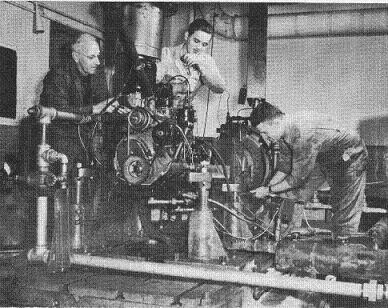 | ||
56packman Member Username: 56packman Post Number: 1017 Registered: 12-2005 |
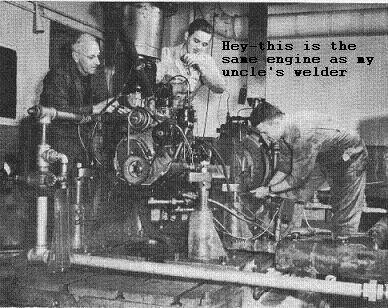 | ||
Kfcoupe Member Username: Kfcoupe Post Number: 31 Registered: 02-2007 |
Graham-Paige had worked with Continental Engines as WWII came to a close to upgrade the prewar 217 cu in L-head 6 to a 226.5 cu in displacement; this version was used in the Kaiser and Frazer automobiles, getting upgrades along the way. Continental also offered it to accounts as the L6226 model and it went into Checker Cabs, certain farm tractor models, and other industrial applications (generators, etc) and was in production years after Kaiser and Willys stopped using their version (K-F bought manufacturing rights to the motor in 1950, after paying Continental royalties for making it in the Jefferson Avenue plant from late 1946). | ||
56packman Member Username: 56packman Post Number: 1019 Registered: 12-2005 |
KFcoupe--has anyone ever put an AMC V-8 (mid '56-up) in a KF car to see what they missed out on? The engineer who designed that engine did so while at KF--they knew they needed it, but couldn't afford the tooling. He walked into his interview at AMC with those blueprints and in George Romney's words "it was like a gift from above" | ||
Kfcoupe Member Username: Kfcoupe Post Number: 32 Registered: 02-2007 |
The AMC engine was never tried as far as I know by anybody, but Kaiser-Frazer came close, VERY close to doing a deal with GM (who was supplying them with Hydra-Matics) to get a de-tuned version of the Olds Rocket 88 starting in the 1952 model year. Unfortunately, the deal hinged on expanding the Olds engine plant at Lansing. The Korean War started and the government decreed no auto plant expansion unless it was coupled to defense work. Olds came back to Kaiser Motors in 1953 to see if they were still interested in getting engines, but by then, management had decided to phase out the Kaiser automobile. | ||
Cambrian Member Username: Cambrian Post Number: 649 Registered: 08-2006 |
You must be speaking of the 250 287 327 V8 Pack man. The engine commonly confused by non AMCers as Ford or Chevy V8s. Of course you know the rest of the story AMC was left flat footed prior to the gift of the new recruit from KF by the Packard Studebaker merger in 1956 when the Packard 356? was phased out of production. | ||
56packman Member Username: 56packman Post Number: 1020 Registered: 12-2005 |
Cambrian--AMC began production of the new AMC V-8 before Curtis-Wright, the new owners of Studebaker-Packard shut down the Utica engine plant in july of 1956 (now Visteon plant on Mound/22 mile). AMC electively dumped the Packard 352 V-8 in the spring of '56 in favor of their own engine. It was just more bad news for SP, who had about all the bad news they could handle for the last 10 months. AMC stamped the oil pans and valve covers for the Packard V-8's as part of their reciprocal agreement. It's funny how people think that an auto company "owns" a particular cubic inch displacement. Studebaker made a 289 V-8 "must be a Ford" AMC made a 327 "must be a Chevy" | ||
Cambrian Member Username: Cambrian Post Number: 651 Registered: 08-2006 |
That is an interesting take Packman, I've always heard it told that packard was the antagonist in that tale. I'll have to ask Uncle Tom D, an automotive historical expert in his own mind ;-) | ||
56packman Member Username: 56packman Post Number: 1021 Registered: 12-2005 |
Packard had nothing to gain by discontinuing the sale of engines and transmissions to AMC, and everything to lose. They lost hundreds of millions of dollars worth of military contracts thanks to "engine Charlie's" preference to send all new defense contracts to his old employer, GM. A great deal of the break-even costs of the Utica engine plant were predicated on engine sales to AMC. Here's a good book to read: http://www.alibris.com/search/ search.cfm?qwork=2239120&match es=5&qsort=r | ||
Kfcoupe Member Username: Kfcoupe Post Number: 33 Registered: 02-2007 |
According to my old contacts who were Nash/AMC people, the problem with the drivetrains were twofold. First, AMC could make the engine and buy Chrysler Torqueflite's for less than S-P charged for the V-8/Ultramatic system. Second, because Packard engineering skimped on bearings and certain other internal components, the Ultramatics did not hold up that well and were expensive to diagnose (the diaognostic required 4 hours and special equipment)and repair. AMC firesaled out the bulk of their service parts inventory on engines and complete transmissions in 1958 (I have the memo and price schedule in my AMC files) | ||
56packman Member Username: 56packman Post Number: 1024 Registered: 12-2005 |
The Ultramatic is a much-maligned transmission. We Packard guys have learned our way around them, and aren't afraid of them. It must be said at this point that in 1955-1956 there was only one competent automatic transmission being produced anywhere in the world: the GM Hydramatic four speed. Its use in tanks in WWII caused 15 years of R&D to happen in 3 years. The need to "just do what is right" on the Hydramatic during the war resulted in materials and processes that made for a very sturdy unit. The Chrysler powerflite was pretty good too, but the first Torqueflite (one of the best auto transmissions ever made) didn't come out until mid '56. The Ultramatic was a typical "young" design--it made its debut in 1950 and was only produced until 1956. That isn’t a lot of time to refine a design, especially for a small company. The Ultramatic was dependant on bearing fit to retain oil pressure. I have over 76,000 miles on my Ultramatic, and it's still great. Packard was the only independent to make their own automatic transmission. They were making one years before Ford made their own (Ford bought Hydramatics from GM for the Lincoln line). Packard also lacked the kind of money that a large big three conglomerate could spend on a transmission, knowing that those costs would be amortized over several hundred thousand units a month, used in a multitude of products. I re-read the portion in Neal's book last night re: the V-8 engine sales to AMC. Romney wanted to buy Studebaker V-8's from S-P as a V-8 powerplant for their 1955 smaller cars. Nance refused, which was a bad decision. That was the tipping point when AMC decided to invest in their own V-8 engine (a good decision, to be self reliant on a very important component) and go on their own. The Ultramatic would have seen the steady, continuous improvement that all automatics had to make throughout the 1950's had they been able to invest more by selling more. Had George Mason's original concept of AMC resulted (the merger of Packard, Hudson, Nash and Studebaker) there could have been cross-pollination of engineering departments and the kind of budgets that come with large scale shared manufacturing. But it didn't, Packard was out there on its own, and making your own trans was expensive. AMC did not use the Chrysler Torqueflite until 1973, they bought Borg-Warner auto transmissions until then (the mighty Ford motor company bought B-W's for the Ford and Mercury line until about '53) | ||
Mikem Member Username: Mikem Post Number: 3085 Registered: 10-2003 |
Bate, to answer your question: yes the rest of Ternstedt is still standing. 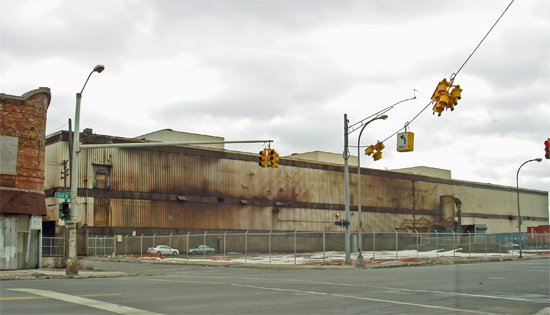 | ||
Mikem Member Username: Mikem Post Number: 3106 Registered: 10-2003 |
Found this in a Chrysler employee magazine from 1956: 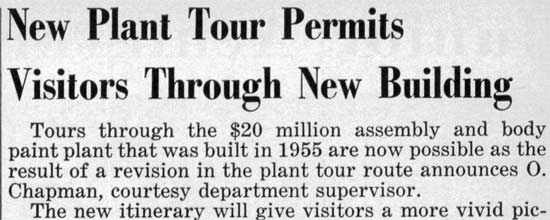 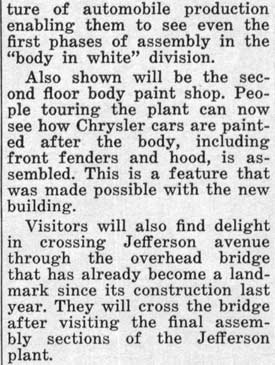 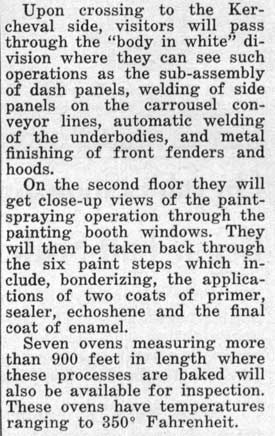 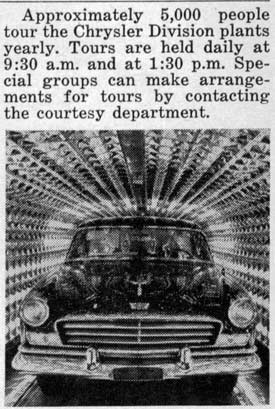 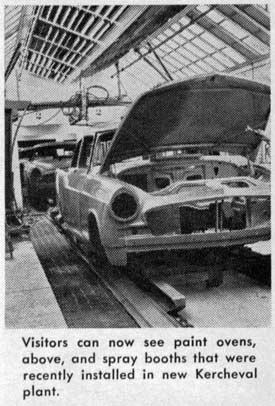 Sorry about the gaps, the new format of the board automatically inserts gaps between jpg's. | ||
Aiw Member Username: Aiw Post Number: 6194 Registered: 10-2003 |
I received this e-mail today... quote: |
